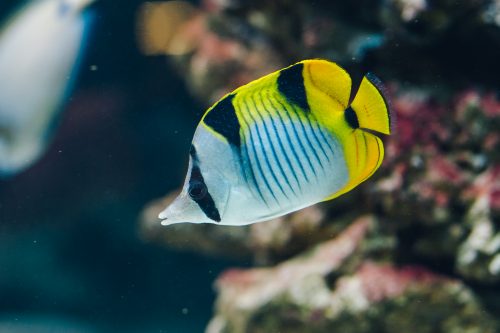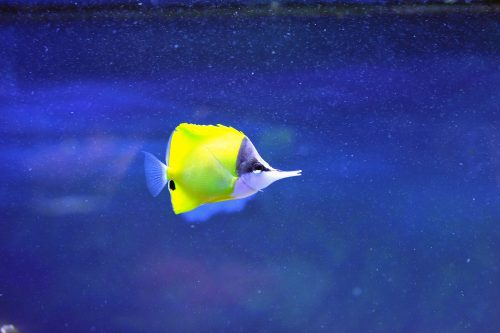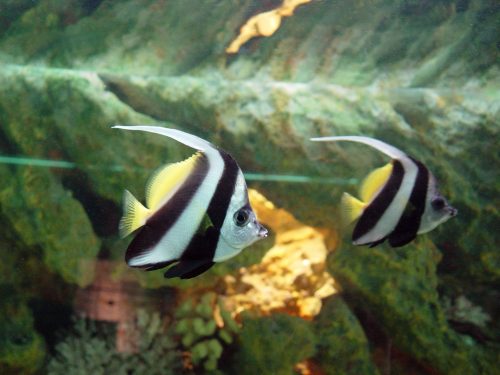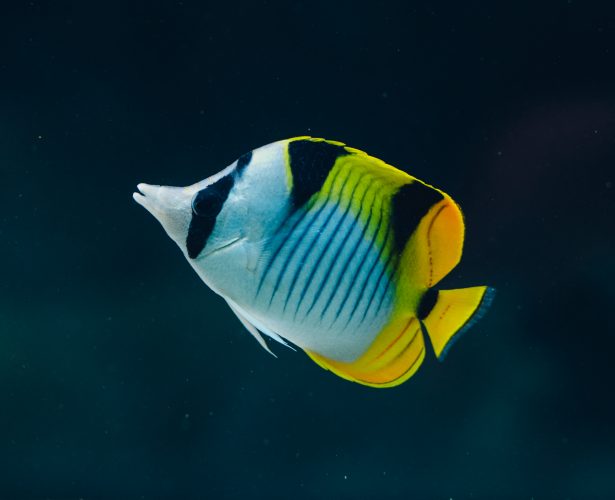Order: Perciformes
Family: Chaetodontidae (butterflyfish)

In the Chetonidae family, 132 species of fish were distinguished, belonging to 12 different genera, most of them included in the genus Chaetodon. These animals are associated with the tropical waters of the Pacific, Atlantic and Indian Oceans. Some also prefer warm temperate waters. The greatest diversity and abundance of Chetonidae is found in the Indo-West Pacific, from Australia to Taiwan. Only 4 species are found in the eastern waters of the Pacific Ocean and 13 species in the Atlantic Ocean.
Habitat
These fish are closely related to coral reefs. They can also live among seagrass, in deep muddy plains or in shallow lagoons. Juveniles of many species inhabit areas other than mature ones, such as tidal basins, rock reefs, and shallow coral-free areas. Chaetodontidae are most commonly found in shallow waters below 20 meters deep, but some species are seen at depths around 200 meters. Although they are typically marine animals, some are also found in brackish waters of estuaries.
Life
These animals move around the reef very actively during the day and then forage, while at night they hide in crevices and change their coloration to a more subdued one. They usually live in pairs. Fish that eat zooplankton form herds, while juveniles are loners. The body size of the fish varies depending on the species between 9 and 22 cm in length. The largest species, such as the Lined butterfly (Chaetodon lineolatus) and the Saddle butterflyfish (Chaetodon ephippium), can grow up to 30 cm in length. Sources do not provide specific information on the lifespan of these fish. On the basis of information that they reach sexual maturity after one year, it can be concluded that most species live for at least 3 years.
Appearance

The English name of this family “butterflyfish” refers to butterflies, due to brightly colored and patterned bodies of many species, in shades of black, white, blue, red, orange and yellow. Many of them have eyelets on the sides of the body and dark streaks over the eyes, much like the patterns seen on butterfly wings. Their clear coloration can be used for interspecies communication. Although they differ significantly in color, they have some common features. They all have a deep, laterally flattened body. They look almost round from the side. Their dorsal and caudal fins are continuous, emphasizing the oval shape of the fish’s body. The scales covering the body also overlap the dorsal and anal fins. Their pointed snouts are tipped with tiny mouth armed with toothbrush-like teeth. The degree of elongation of the mouth depends on the food consumed. Some species, such as the Forceps butterflyfish (Forcipiger flavissimus), have extra-long tweezers-like jaws that can pick invertebrates from narrow slits. Others, such as the Ornate butterflyfish (Chaetodon ornatissimus), have short jaws for picking live coral polyps. The jaws of some butterflyfishes may account for more than 25% of the body length of a fish.
Feeding
Many species feed on small invertebrates, sponges, fish eggs, thread algae, and others on zooplankton. Some species only feed on coral polyps. Species that feed on algae growing on corals contribute to their protection by removing competing species that take away the light access.
Reproduction
They are dioecious, but there is no obvious sexual dimorphism. They are animals that form monogamous pairs. Most species stay with the same mate for several years, while some species mate for life. Couples accompanied by a juvenile were occasionally observed. This suggests that the young are asexual or capable of maturing into a male or a female, depending on the needs. However, this information has not been confirmed. Based on data collected for several species, it has been found that the spawning season in tropical waters peaks in winter and early spring, while species in temperate areas reproduce in the middle of summer. Some groups reproduce all year round. Spawning usually takes place at dusk. The male swims behind and under the female, poking her with his mouth in a belly filled with eggs. The release of gametes (eggs and sperm) takes place in the water column about 10-15 meters above the bottom. In some species, other males have been seen swimming in a pair during spawning and releasing their sperm. Approximately 28-30 hours after fertilization, a pelagic larva hatches from the egg and hangs upside down just below the water’s surface. This is due to the presence of oil droplets. In their development there is so called tholichthys larval stage, unique among reef fish, in which the animal’s head is covered with ‘armor’ made of thin bone plates that extend beyond the head to form dorsal and abdominal spines. The shape and form of the plates and spikes varies from species to species. All tholischthys larvae are silver in color, have a deep body flattened laterally. Bone plates are absorbed within a few weeks after the larvae sink to the bottom. The larvae settle during the night and quickly develop into juveniles. In many species, the coloration of juveniles is different from that of adults.
Masking coloration
Butterflyfishes do not take care for their offspring. Due to the small size of the body, they can easily fall prey to predators. Therefore, most species have a band covering the eye and a dark spot, the so-called false eye, located near the tail. These intend to confuse predators that aim for the head but actually attack the back of the fish’s body. Due to their attractive coloration, they are popular as aquarium fish. When selecting the appropriate species, however, it should be remembered that some of them feed on corals and anemones, which is why species that eat zooplankton are more popular.
Butterflyfishes as indicator species
Representatives of the Chetonidae family are considered indicator species that testify to the condition of coral reefs. This is due to the fact that they are bound to this habitat. Of the 5,000 species of fish that live on coral reefs, only 41 of them feed exclusively on corals. The majority, as much as 61%, belongs to the Chaetodontidae family, which is 25 species out of the previously mentioned 41. The dying of reefs contributes to the reduction of the number and diversity of butterflyfishes.
Pennant coralfish Heniochus acuminatus

Butterflyfishes are the most popular tropical fish among divers and aquarists. Among them is the Pennant coralfish belonging to the genus Heniochus, inhabiting the tropical waters of the Indo-Pacific, from East Africa, through South Japan to New Guinea. It inhabits coral reefs and sheltered coastal bays. Mature individuals are usually found in pairs, sometimes forming herds, while juveniles are solitary. The body length of the Pennant coralfish ranges from 15 to 20 cm. It can be distinguished from other representatives of Chetonidae by its elongated back and bony protuberance on the head. The length of the ridge on the back increases as the fish matures. Its oval, laterally flattened body is white with two broad black bands running vertically behind the eye and behind the dorsal process. Yellow dorsal and caudal fins are also characteristic. This fish has a long snout that allows it to reach its main food source in the crevices of coral reefs, i.e. small invertebrates. It also does not despise coral polyps. Juveniles sometimes clear other fish of parasites. Little is known about the reproduction of this species. It produces small, floating pelagic eggs. Hatching time is 18 to 30 hours. The previously described stage of tholichthys is present in their larval development. The larvae remain at this stage for several months and are then planktonic. H. acuminatus is a very beautiful and popular fish, quite easy to care for, which is why it is sold as an aquarium fish.


